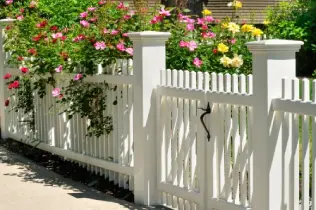Fence Ideas: Choosing the Perfect Fence Style or Design to Match Your Home

While the white picket fence has long symbolized the American dream of home ownership, you do have other options. Choose the fence type that best suits your home using the following information and tools.
Fence Types
Wood Fencing - These fences come in picket, split and privacy styles. Which you get depends on the purpose of the fence and your preference. Picket fences are great for keeping small children and animals inside the yard. Split rail has more decorative appeal, but would only keep large animals that could not go over or under from escaping or coming in. Privacy fences work best when you want to keep kids and pets in while also thwarting nosy neighbors. They typically come in cedar and redwood, and the styles vary from basic dog-ear to those with more elaborate detail work such as lattice and spindle.
- Natural look that suits many different home-building materials, including wood siding and brick
- Affordability
- Ability to stain or paint
- Ease of repair
- Can last 10 to 15 years if maintained properly
- Yearly maintenance needed
- Risk of rot or warping in wet climates
- Risk of termite infestation
Vinyl Fencing - If you want a lower maintenance in styles similar to that of wood fences, a vinyl fence may be the best fit. They also come in styles that suit both purpose and preference, with even more options because of the manufacturing process.
- Suits a variety of home-building materials
- Available in white, tan, gray and other neutral colors; no staining or painting required
- Little to no maintenance
- Not susceptible to rot, warping or insects
- Typically comes with a lifetime guarantee
- Ease of repair
- Available with treatment to prevent discoloration
- Higher cost than wood
- Can look plastic in appearance depending on the quality
Chain-Link Fencing - This type of fencing costs the least of all options. It comes in different gauges, from nine to 11, with the lower gauge chain link offering the most durability. Chain-link fencing is a common sight in both residential and commercial settings.
- Low cost
- Flexibility allows it to stand up to weather better than other types
- Unattractive look
- No privacy
Additional types of fencing exist, such as decorative metal, with some types qualifying more as walls, such as cinderblock. Both are expensive options in terms of materials and installation.
Types of Gates
Just as fencing can vary from basic to decorative, so can gates. You typically purchase the gate in the same material as your fence, with the smaller section that opens and closes allowing you to add detail just in that spot. If you pull through your fence into your driveway, you can even opt for an automatic gate.
Fence Design Software
Fencing costs a pretty penny, no matter the material because of the amount you need to enclose a space. You should be sure of your choice before making any purchases. You wouldn't want to put it up and not like it, after all. It's not like you can simply switch it out for a new one.
To help finalize your decision, you can use fence design software such as that available through the Big Hammer website. It allows you to design online a custom fence that suits your needs and wants, and it gives you multiple views and 3D rotation. It even provides you with printouts building permits and a materials list, among many other features.
You can also enlist your professional handyman early in the process. He or she can help you choose the right materials and style for your home, as well as install the fence for you.
Mr. Handyman can maintain your home to save you money. One call really does take care of everything on your to-do list. Make sure to stay on top of all your household repairs, improvements and maintenance needs and request service now online.
 Click to call
Click to call


